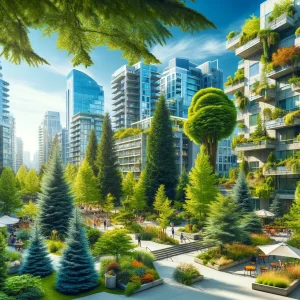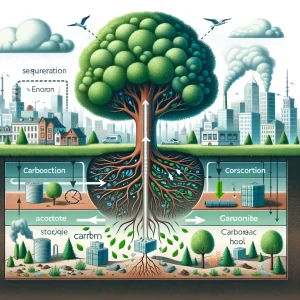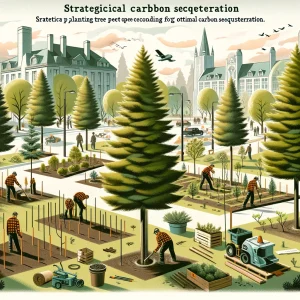In urban environments, where concrete often dominates the skyline, trees serve as essential ecosystem components, not just for beautification but also for their critical role in combating climate change. For British Columbia landscapers, understanding trees’ function in carbon sequestration presents an opportunity to contribute significantly to climate change mitigation through thoughtful urban planning and landscaping.

Understanding Carbon Sequestration
Carbon sequestration is when trees and plants absorb carbon dioxide (CO2) from the atmosphere during photosynthesis, storing carbon within their tissues and in the soil. In urban settings, this natural function helps mitigate the concentration of greenhouse gases, thus reducing the urban heat island effect and contributing to cooler city environments.

Best Trees for Carbon Absorption in Urban British Columbia
When selecting tree species for carbon sequestration in British Columbia, landscapers should consider growth rate, biomass accumulation, and adaptability to urban conditions. Some of the most effective trees include:
- Douglas Fir: Known for its rapid growth and high carbon storage capacity, it is ideal for larger green spaces.
- Western Red Cedar thrives in the moist, coastal climate of British Columbia and accumulates substantial biomass.
- Broadleaf Maple: Offers excellent carbon storage and adds aesthetic value to urban landscapes due to its vibrant fall colour.

Practical Landscaping Techniques
Incorporating trees into urban landscapes requires more than just planting. Here are some practical tips for landscapers:
- Strategic Planting: Place trees in locations where they can grow to their full size and provide maximum shade and cooling effects. Consider the sun’s path and wind patterns for optimal placement.
- Soil Preparation: Ensure the soil conditions suit the selected trees. Urban soil often needs amendment to support healthy tree growth.
- Water Management: Implement efficient irrigation strategies that conserve water while ensuring trees receive the moisture they need, particularly during the drier summer months in British Columbia.

Maintenance and Care
Post-planting care is crucial for the survival and effectiveness of trees in urban landscapes:
- Regular Pruning helps maintain tree health and aesthetics and ensures trees do not interfere with urban infrastructure.
- Pest and Disease Management: Regular monitoring and environmentally friendly management practices can prevent the spread of pests and diseases, which can compromise tree health and carbon sequestration capacity.
- Mulching: Applying mulch around the base of trees helps retain soil moisture, suppress weeds, and provide nutrients as it decomposes.

Challenges and Solutions
Urban areas in British Columbia face unique challenges, such as limited planting space and specific environmental conditions. Innovative solutions like vertical gardens and rooftop planting can augment the need for more ground space. Additionally, selecting tree species that can withstand urban pollutants and confined soil spaces is critical.
For landscapers in British Columbia, planting trees enhances the visual appeal of urban areas and profoundly contributes to environmental sustainability. By choosing suitable species and employing effective landscaping and maintenance techniques, landscapers can play a pivotal role in carbon sequestration, helping mitigate climate change’s effects while creating healthier, more livable urban spaces.